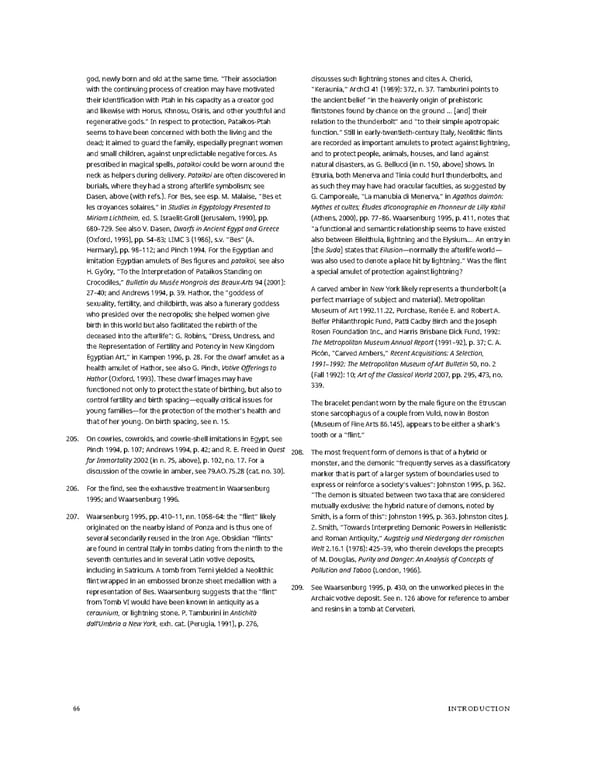god, newly born and old at the same time. “Their association discusses such lightning stones and cites A. Cherici, with the continuing process of creation may have motivated “Keraunia,” ArchCl 41 (1989): 372, n. 37. Tamburini points to their identification with Ptah in his capacity as a creator god the ancient belief “in the heavenly origin of prehistoric and likewise with Horus, Khnosu, Osiris, and other youthful and flintstones found by chance on the ground … [and] their regenerative gods.” In respect to protection, Pataikos-Ptah relation to the thunderbolt” and “to their simple apotropaic seems to have been concerned with both the living and the function.” Still in early-twentieth-century Italy, Neolithic flints dead; it aimed to guard the family, especially pregnant women are recorded as important amulets to protect against lightning, and small children, against unpredictable negative forces. As and to protect people, animals, houses, and land against prescribed in magical spells, pataikoi could be worn around the natural disasters, as G. Bellucci (in n. 150, above) shows. In neck as helpers during delivery. Pataikoi are often discovered in Etruria, both Menerva and Tinia could hurl thunderbolts, and burials, where they had a strong afterlife symbolism; see as such they may have had oracular faculties, as suggested by Dasen, above (with refs.). For Bes, see esp. M. Malaise, “Bes et G. Camporeale, “La manubia di Menerva,” in Agathos daimōn: les croyances solaires,” in Studies in Egyptology Presented to Mythes et cultes; Études d’iconographie en l’honneur de Lilly Kahil Miriam Lichtheim, ed. S. Israelit-Groll (Jerusalem, 1990), pp. (Athens, 2000), pp. 77–86. Waarsenburg 1995, p. 411, notes that 680–729. See also V. Dasen, Dwarfs in Ancient Egypt and Greece “a functional and semantic relationship seems to have existed (Oxford, 1993), pp. 54–83; LIMC 3 (1986), s.v. “Bes” (A. also between Eileithuia, lightning and the Elysium.… An entry in Hermary), pp. 98–112; and Pinch 1994. For the Egyptian and [the Suda] states that Eilusion—normally the afterlife world— imitation Egyptian amulets of Bes figures and pataikoi, see also was also used to denote a place hit by lightning.” Was the flint H. Győry, “To the Interpretation of Pataikos Standing on a special amulet of protection against lightning? Crocodiles,” Bulletin du Musée Hongrois des Beaux-Arts 94 (2001): A carved amber in New York likely represents a thunderbolt (a 27–40; and Andrews 1994, p. 39. Hathor, the “goddess of perfect marriage of subject and material). Metropolitan sexuality, fertility, and childbirth, was also a funerary goddess Museum of Art 1992.11.22, Purchase, Renée E. and Robert A. who presided over the necropolis; she helped women give Belfer Philanthropic Fund, Patti Cadby Birch and the Joseph birth in this world but also facilitated the rebirth of the Rosen Foundation Inc., and Harris Brisbane Dick Fund, 1992: deceased into the afterlife”: G. Robins, “Dress, Undress, and The Metropolitan Museum Annual Report (1991–92), p. 37; C. A. the Representation of Fertility and Potency in New Kingdom Picón, “Carved Ambers,” Recent Acquisitions: A Selection, Egyptian Art,” in Kampen 1996, p. 28. For the dwarf amulet as a 1991–1992: The Metropolitan Museum of Art Bulletin 50, no. 2 health amulet of Hathor, see also G. Pinch, Votive Offerings to (Fall 1992): 10; Art of the Classical World 2007, pp. 295, 473, no. Hathor (Oxford, 1993). These dwarf images may have 339. functioned not only to protect the state of birthing, but also to control fertility and birth spacing—equally critical issues for The bracelet pendant worn by the male figure on the Etruscan young families—for the protection of the mother’s health and stone sarcophagus of a couple from Vulci, now in Boston that of her young. On birth spacing, see n. 15. (Museum of Fine Arts 86.145), appears to be either a shark’s 205. On cowries, cowroids, and cowrie-shell imitations in Egypt, see tooth or a “flint.” Pinch 1994, p. 107; Andrews 1994, p. 42; and R. E. Freed in Quest 208. The most frequent form of demons is that of a hybrid or for Immortality 2002 (in n. 75, above), p. 102, no. 17. For a monster, and the demonic “frequently serves as a classificatory discussion of the cowrie in amber, see 79.AO.75.28 (cat. no. 30). marker that is part of a larger system of boundaries used to 206. For the find, see the exhaustive treatment in Waarsenburg express or reinforce a society’s values”: Johnston 1995, p. 362. 1995; and Waarsenburg 1996. “The demon is situated between two taxa that are considered mutually exclusive: the hybrid nature of demons, noted by 207. Waarsenburg 1995, pp. 410–11, nn. 1058–64: the “flint” likely Smith, is a form of this”: Johnston 1995, p. 363. Johnston cites J. originated on the nearby island of Ponza and is thus one of Z. Smith, “Towards Interpreting Demonic Powers in Hellenistic several secondarily reused in the Iron Age. Obsidian “flints” and Roman Antiquity,” Augsteig und Niedergang der römischen are found in central Italy in tombs dating from the ninth to the Welt 2.16.1 (1978): 425–39, who therein develops the precepts seventh centuries and in several Latin votive deposits, of M. Douglas, Purity and Danger: An Analysis of Concepts of including in Satricum. A tomb from Terni yielded a Neolithic Pollution and Taboo (London, 1966). flint wrapped in an embossed bronze sheet medallion with a 209. SeeWaarsenburg 1995, p. 430, on the unworked pieces in the representation of Bes. Waarsenburg suggests that the “flint” Archaic votive deposit. See n. 126 above for reference to amber from Tomb VI would have been known in antiquity as a and resins in a tomb at Cerveteri. ceraunium, or lightning stone. P. Tamburini in Antichità dall’Umbria a New York, exh. cat. (Perugia, 1991), p. 276, 66 INTRODUCTION
 Ancient Carved Ambers in the J. Paul Getty Museum Page 75 Page 77
Ancient Carved Ambers in the J. Paul Getty Museum Page 75 Page 77